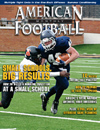Article CategoriesAFM Magazine
|
Coaching in Denmark© More from this issueBy Wayne Anderson I joined the Odense Swans in Denmark as their head coach on May 18th. Having coached in Norway and Italy prior to this position, traveling overseas was not a new experience; however, there are always unique challenges with each destination. With eight years of seasonal coaching positions, my wife and I have a routine when preparing me for the season away from home. When preparing to coach in Europe, I have to be more thoughtful about space for clothes, coaching materials, personal items and even favorite foods I like. I cannot find crunchy peanut butter in Denmark comparable to my favorite USA brand. Paperwork is crucial and this year traveling to Denmark presented new obstacles with a change in the Danish immigration policies.....The full article can only be seen by subscribers.
|
|
|||||||
| HOME |
MAGAZINE |
SUBSCRIBE | ONLINE COLUMNISTS | COACHING VIDEOS |
Copyright 2025, AmericanFootballMonthly.com
All Rights Reserved





